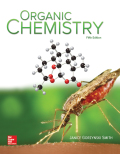
Concept explainers
(a)
Interpretation: The protons on the highlighted carbons of the given compound that absorbs farther downfield are to be identified.
Concept introduction: Depending upon the electron density or the concentration of electron around the proton the chemical shift values of the proton varies relative to the reference signal. The terms, upfield and downfield expresses the relative location of signals. The meaning of upfield is to the right and of downfield is to the left.
(b)
Interpretation: The protons on the highlighted carbons of the given compound that absorbs farther downfield are to be identified.
Concept introduction: Depending upon the electron density or the concentration of electron around the proton the chemical shift values of the proton varies relative to the reference signal. The terms, upfield and downfield expresses the relative location of signals. The meaning of upfield is to the right and of downfield is to the left.
(c)
Interpretation: The protons on the highlighted carbons of the given compound that absorbs farther downfield are to be identified.
Concept introduction: Depending upon the electron density or the concentration of electron around the proton the chemical shift values of the proton varies relative to the reference signal. The terms, upfield and downfield expresses the relative location of signals. The meaning of upfield is to the right and of downfield is to the left.
Trending nowThis is a popular solution!

Chapter 14 Solutions
Organic Chemistry
- Can we say because of the one i circle with red in the paper , can we say we have aromatic overtone on both that region with benzoic acid ir spectum thank uarrow_forwardSpectrum 2. Match the correct compound to the given NMR spectra. On the spectrum, match the signals on the NMR with the protons of the structure (use arrows to point or use letter or number designations).arrow_forward
 EBK A SMALL SCALE APPROACH TO ORGANIC LChemistryISBN:9781305446021Author:LampmanPublisher:CENGAGE LEARNING - CONSIGNMENT
EBK A SMALL SCALE APPROACH TO ORGANIC LChemistryISBN:9781305446021Author:LampmanPublisher:CENGAGE LEARNING - CONSIGNMENT
